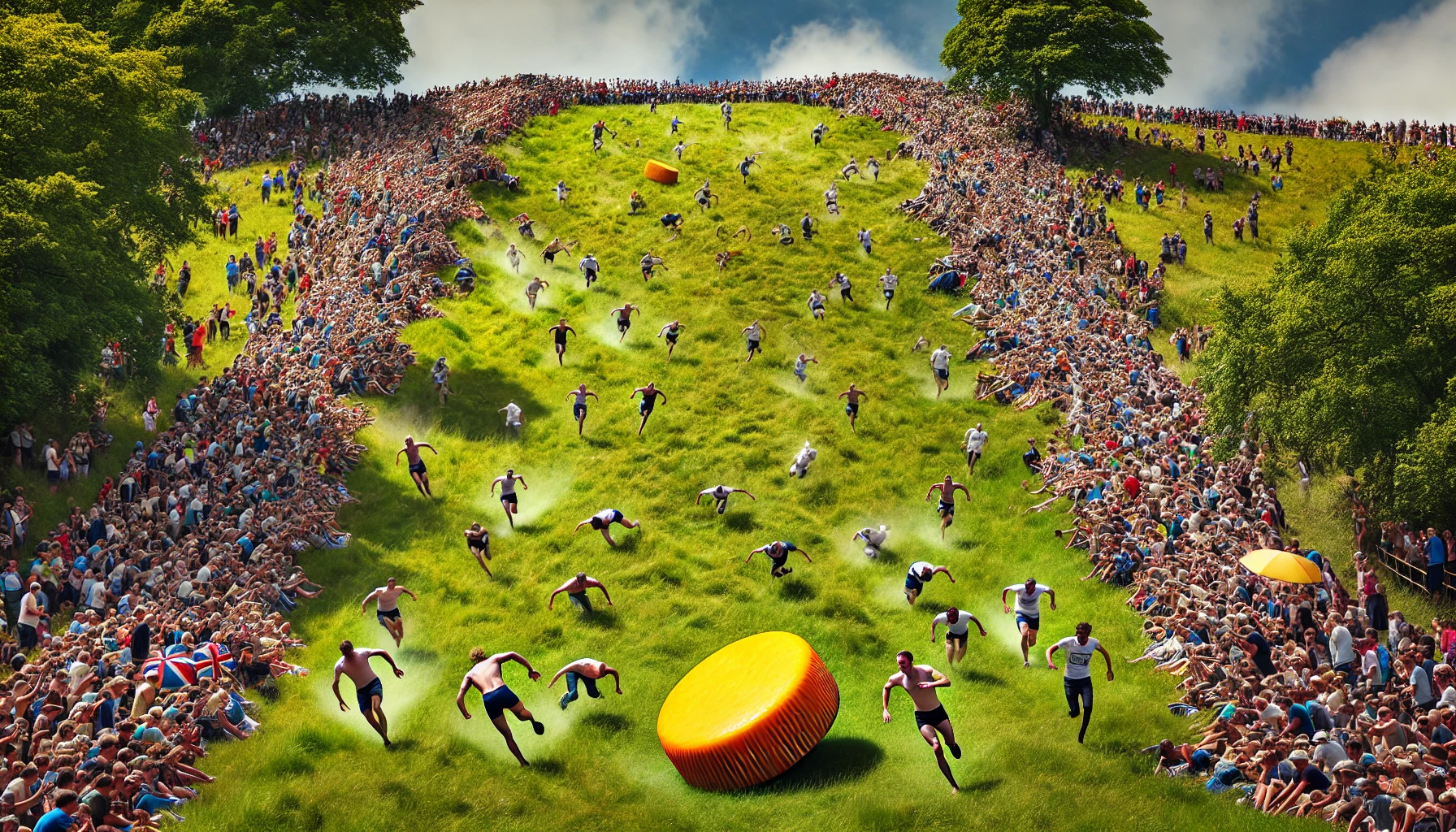
Cheese Rolling is one of England’s most eccentric and exhilarating traditions, drawing participants and spectators from around the globe to the steep slopes of Cooper’s Hill. This quirky event, steeped in history, has become a symbol of local pride and an embodiment of English eccentricity. The annual spectacle is not just a race against gravity but also a celebration of community, tradition, and the sheer joy of embracing the absurd.
The History and Origins of Cheese Rolling
Cheese Rolling at Cooper’s Hill is a tradition that dates back centuries, though its exact origins are somewhat shrouded in mystery. Some historians believe the event may have pagan roots, tied to the celebration of the spring harvest. The rolling of the cheese, symbolizing the sun, could have been part of ancient rituals to ensure a bountiful season.
The first recorded mention of Cheese Rolling dates back to the early 19th century, although it is widely believed that the event was already well-established by then. The custom of rolling a round of cheese down a hill and racing after it may have started as a way to mark the beginning of summer, or perhaps as a playful competition among local farmers.
Over time, Cheese Rolling has evolved from a local pastime into an internationally recognized event. Despite occasional concerns about safety and the future of the tradition, the event has persisted, largely thanks to the passion of the local community and the allure of its inherent thrill.
The Thrill of the Chase: How Cheese Rolling Works
The basic premise of Cheese Rolling is deceptively simple: a round of Double Gloucester cheese is sent hurtling down the steep and uneven slope of Cooper’s Hill, and competitors race after it. The first person to cross the finish line at the bottom of the hill is declared the winner and gets to take home the cheese.
However, the reality of Cheese Rolling is far more challenging and chaotic. The cheese can reach speeds of up to 70 miles per hour, making it nearly impossible to catch. The hill itself is treacherous, with a gradient of around 50%, riddled with bumps, dips, and unexpected obstacles. As competitors hurl themselves down the slope, they often lose their footing, resulting in dramatic tumbles, flips, and sometimes injuries.
Participants range from seasoned veterans who return year after year, to adventurous first-timers eager to test their mettle. For many, winning is secondary to the thrill of the chase and the sheer joy of participating in such a unique event. The crowd, too, plays a vital role, cheering on the competitors and adding to the electric atmosphere.
The Cultural Significance of Cheese Rolling
Cheese Rolling is more than just a quirky race; it is a vital part of the local culture and a source of community pride. The event is deeply rooted in the identity of the Gloucestershire region, particularly for the residents of Brockworth, the village at the foot of Cooper’s Hill. For them, Cheese Rolling is a tradition that has been passed down through generations, a connection to their ancestors, and a symbol of their resilience and spirit.
The event also attracts a global audience, drawing visitors from far and wide. For international spectators, Cheese Rolling represents the quintessentially British penchant for the peculiar. It is an event that defies logic, yet embodies the joy of tradition and the human desire to celebrate life’s absurdities.
In recent years, Cheese Rolling has also become a social media sensation, with videos of the event going viral and attracting millions of views. This global attention has helped sustain the tradition, ensuring that it continues to thrive in the modern era.
Preparing for Cheese Rolling: What You Need to Know
If you’re considering participating in Cheese Rolling, or simply planning to attend as a spectator, there are a few things you should know. First and foremost, safety is a major consideration. The steepness of Cooper’s Hill, combined with the speed of the cheese and the unpredictability of the race, makes for a potentially dangerous event. Many competitors end up with cuts, bruises, or worse, so it’s important to be prepared.
For participants, wearing appropriate clothing is essential. Sturdy shoes with good grip are a must, as is protective gear like knee and elbow pads. It’s also advisable to bring a change of clothes, as the hill can be muddy and wet, especially if it has rained recently.
Spectators should arrive early to secure a good viewing spot, as the event draws large crowds. The atmosphere is lively and festive, with food stalls, local vendors, and entertainment adding to the experience. However, be prepared for some rough terrain, as the viewing areas are often steep and uneven.
In terms of logistics, Cooper’s Hill is located near Gloucester, and the event typically takes place on the Spring Bank Holiday Monday in late May. There is no formal registration process for participants, as the race operates on a first-come, first-served basis. For those traveling from afar, booking accommodation in advance is recommended, as local hotels and inns tend to fill up quickly.
The Future of Cheese Rolling
Despite its enduring popularity, the future of Cheese Rolling has occasionally been called into question. Concerns over safety, liability, and the sheer unpredictability of the event have led to debates about whether it should continue in its current form.
In 2010, the official Cheese Rolling event was canceled due to safety concerns, but the local community, determined to keep the tradition alive, organized an unofficial version of the race. Since then, the event has continued in a more informal capacity, with locals and visitors alike coming together to celebrate the age-old tradition.
Looking ahead, it is clear that Cheese Rolling will likely continue to evolve. There may be increased efforts to ensure participant safety, possibly through better crowd management, improved medical facilities, and more structured participation rules. However, the spirit of Cheese Rolling—its spontaneity, its chaos, and its sense of fun—is likely to remain intact.
The global attention the event receives, especially through social media, suggests that Cheese Rolling will remain a fixture in the cultural calendar for years to come. Whether it continues as an official event or as a community-organized celebration, the tradition of Cheese Rolling is deeply ingrained in the hearts of those who participate and spectate. The thrill of the chase, the laughter, and the sense of camaraderie are all part of what makes Cheese Rolling such a beloved and enduring event.
In conclusion, Cheese Rolling is more than just a race down a hill; it is a celebration of tradition, community, and the joy of embracing the absurd. Whether you’re a participant, a spectator, or simply an admirer from afar, there’s no denying the unique charm and allure of this quirky English tradition.








